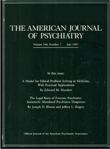You have to admire the chutzpah of an author of a scientific book on violence who puts on the cover a picture (by Goya) of a friar shooting a rifle at an unarmed man. Dr. Volavka has not written an anticlerical polemic but an excellent review of what we know about the biology of violence. I am particularly impressed that he is the sole author of this critical review of a large area, including aggression in animals, neurochemistry of violence in animals and humans, neurological correlates, genetic effects, obstetrical and perinatal factors, effects of ethnicity and gender, and the relationship of various psychopathological states to violence. This gives the reader the advantage of a single calm and succinct voice.
I can only hint at the richness of this book. Dr. Volavka does not hesitate to offer wide theories as well as presenting a profusion of relevant facts. He rejects static nature/nurture main effects and interactions for an interactive model of one variable, mental or physical, influencing another variable over time, reminding us that causative tracks go all ways: a violent child, for example, might bring out violent behavior in adults.
I was particularly impressed by Dr. Volavka's critical reviews. He not only cites studies but reanalyzes the data. For example, in reviewing predictors of violence in hospitalized patients, he cites the largest study, which used 5,525 subjects, half for a linear discriminant analysis to determine predictors and half for a replication sample. Not willing to present the findings only, Dr. Volavka analyzed the data in this study to show that although the specificity of the prediction of violence—96%—was high, sensitivity—25%—was low, and the base rate of violence was only 5%, for which the authors did not adjust in a Bayesian model.
Dr. Volavka correctly describes in what ways studying violent behavior in humans is quite different from studying aggression in animals. Human violence is relatively rare and unpredictable, it varies widely, it usually seems related to environmental events difficult for the researcher to control, and, I would add, we don't know if violence is a unitary factor across diagnoses. All this makes drug studies difficult. Dr. Volavka brings judicious conclusions after presenting the data fairly. For example, regarding the alleged paradoxical reactions to benzodiazepines, Dr. Volavka quotes the anecdotal reports but notices that these patients had had previous violent episodes and that most reports refer to long-term treatment, whereas to treat violent behavior, most clinicians use benzodiazepines short-term. The only systematic data for paradoxical aggression from using benzodiazepines come from paper-and-pencil tests of hostility, which found that the benzodiazepine group showed more aggression than the placebo group, or that one benzodiazepine group showed more aggression than another. I concur with Dr. Volavka's conclusions that we should generalize from these tests to violent behavior only with much caution. If there are paradoxical reactions, they are rare and the effect on clinical practice is limited.
The clear message from Dr Volavka's review of drug treatments of violence is that none has clearly shown efficacy in randomized controlled studies because few such studies have appeared. It seems reasonable to treat violent individuals with schizophrenia, for example, as you would treat other patients with schizophrenia; this would apply to proven effective drug treatments for patients with other disorders. That leaves a huge unexplored territory: patients whose violent behavior does not respond to standard treatments and those disorders, such as personality disorders and impulse disorders, for which we lack proven effective treatment. Given the frequency and seriousness of violent behavior, it seems remarkable that so few studies have been done. The clinician is left with guidance from anecdotal reports and theoretically supportable strategies, e.g., using drugs that increase brain serotonin because violent behavior across several diagnoses is associated with low CSF 5-hydroxyindoleacetic acid. I recommend this book highly.

